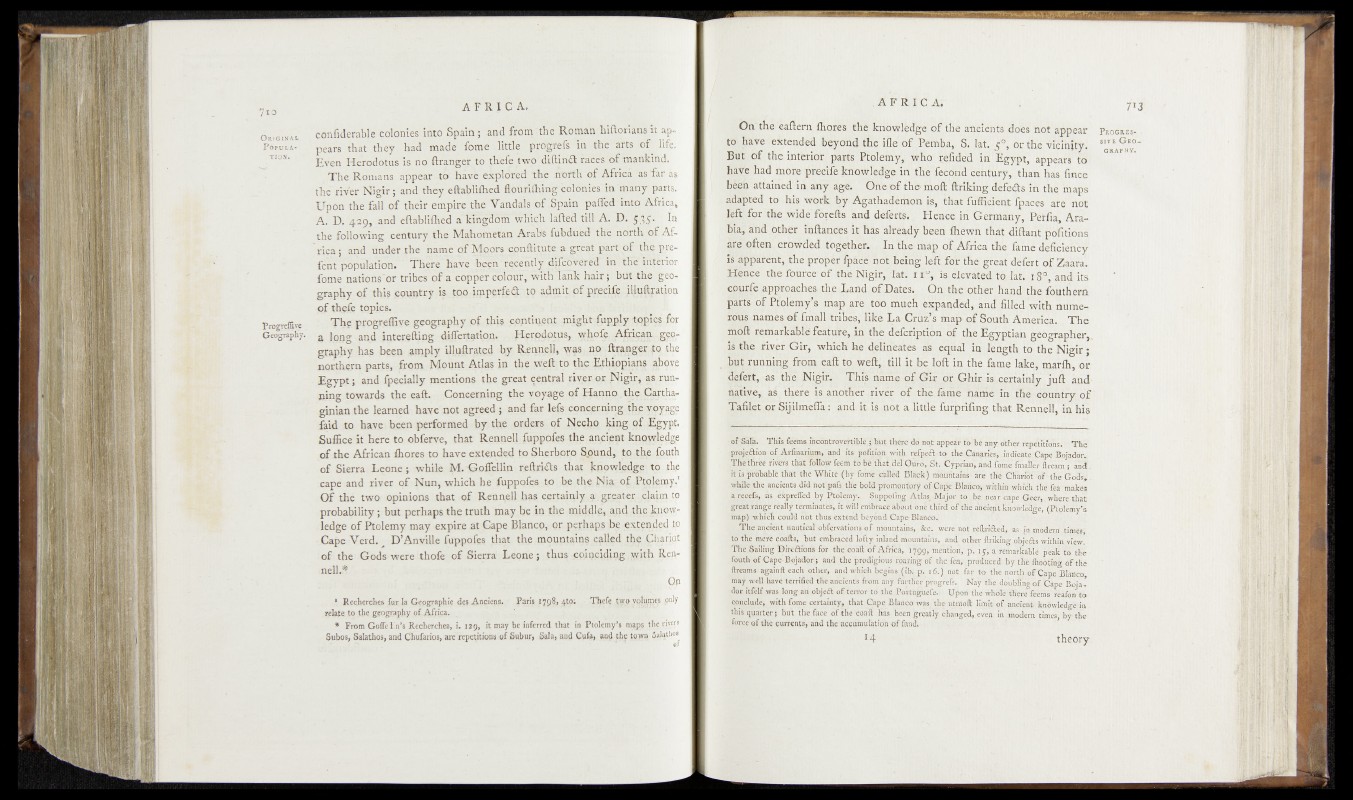
0rigiWap confiderable colonies-into Spain; and from'the 'Roman hiftoriaus it api
Popula- pears that they,'had made- fome ^little prBgrels in the' arts of |tfe.
tion. . ' Even Herodotus is no ftranger to ttóleVwpjfiftina'raQfs of-mankind.
(The Romfris appear to have explored the ftrirth of:Africa as far as
the"river Nigir; and they eftablÉhed flouriftnng’colonies in mauffparts.
Upon the fall of theif empire the Vandals of .Spain p affed -into''Africa;
A. D. 429, .and eftabtfthed a kingdom which lafted till5 A. D. 535- In
- the following century the Mahometan Arabs fubdoed the. north ofjjAf-
rica; apd under^he ‘natne pf Mgars- conftte part of/ the irefènt
population. Thtjre have ^p^n*^cen^V d^ ^ ’Sted in fFie^^ctior
fome nations'or tribes of a copper colour,‘-with lank hair jhbut t|fe geography
of this poultry is1;-tpo4ffipg?ff^;' F<? t, pf /l^j^Mion
of thefe topics.
^ rTfrr. f hrptp^-effiYO ggogr§phy pf tfiis cpptiii,eof .paig^t gipftjy ‘t /M 'f a
Geography. a fepg and |nten|flipg £&f t e i § £ t f o n . j g f l B; *
gjaphy has beep ^mply illiffiratecj % leaped}» the
».qtthej-n parts, from Mount Atlas in the yréft:to the^h^^^ ^ ? ye
Egypt; and fpecially mentions the great central riyere/.^igi^ as running
towards the eaft. .Coneptning thg voyage pf Bantw^t^ft^jtitha-
gfoian the learned hayenot agreed; and far lefs cenj^^n^t-fip yoy^ge
faid to have heen performed by the orders of kipg pJ^Egypt.
Suffice it here to obferve, that Repnelffiippofes fop aqcipfit kqgjyjjf^gp
of the African fhores to have extended f® Shjfbpt'P tQ-tfefcuth
of Sierra Leone ; while J^.-GoffelUq rj2ftj|&.s that jfoqwfoe^gg' fo /#
cape and river of Nun, which be fupppfe^jfo, l^fhf.ll'Jl^QljPt^enfy.,1
Of the two opinions that of ReonpIJ h$tS certainly ,9.';. g^te/.^a^a tf>
probability; but perhaps the truth may be iri the -ifodfofi»
ledge of Ptolemy may expire .at Gape 331aricp,: 0r pefodR? he gxtjqdpiJ >|P
•CapeVerd. D’AnviUe foppqfes that thf
of the Gods were thofe of Sierra Lepne; thu^ :j;pi9cldfog(^ h ^en-
,nell.$
K Ó P
1 Recherches fur la Geographic des Anciens. • Pans 1798, *j.to: .Thefe .two Wunjes only
rekte to the geography of Africa.
* From GofleTn’s Recherches, I. 129, it may be inferred, that in Ptolemy’ s maps the nyers
Subos, Salathos, and Chufarios, are repetitions of Subur, Sala, and Cufa, and the town 5a)|tho‘
■ Kg;
(Dft tfie< eafl^rn5 ft! ore's t-hh kdblwi|‘d^e|bf ipej.afocients appear Progres-
(b\tave elttf^ld b^onfoifoe ifler‘o f |b ® la ,^ |lu t.J f^ or the vicinity. SIT* G*°
But of tn6 ihtbrfof'pirts l^blefnyf ^v|ho'i£efi3;41 uS'ligypt, appears ter
have had in ore iprepifo lihb.wled^e in ^m ^ c ^ r e e n '^ y , foan. basfince '
attaiipd,'ki^l^ y ’. age, ^^fe^lf. foi* moft ^ftrikilig dfefeas m the maps
adapted to bi^^ijk: by,Agitjladei^c^ il," tPat^'ftQxenlfpac& are'hof
lfeft' for the wide“ for efts lin'd deferts. „ er-hii)ay Pepfia^ Arabia,"'
arid qfogr" .ilftplfes^itm-as already been foewn t®l'diftax|^portions'
Ife^qften fcrhyv&d to^eiheh:|Mlhe'rpap ofJAfrica the ;|a,mM^leri£y
apparent, the$fo|>^^^ for foe' great dVehtjof-Zaara.
Hlhce tKi Eigil^fat; 1 . ri^vand its
cgurfe approaches the Land ofjU^iis.i; Op the vptBfe'rjhandiifefouthern
parts of f.toletnyy map pre ^fSmucK ^pahded,^^lfed'Jwith nuiherj
tovk names sf fmalhtrihes,’wfike La^Cruzs Tpar>,bf Sputh A n ^ iS The
moft remarkable feature, in the. dn&riplop^‘qf the jEgyptian geographer,,
is-the river G^, which he delineates , equal ur „.length to the Nigir;
running frqin «aft to weft, tlll.it be loftJn the fame like, marlh or
aeferi, as trie Ni^ir. This name of-Guh or Ghin I^®^aimy juft and-
native, as there is another river 'of ,the lame ftam#’ m 'the' Gpun|ry^of
f^afiilet or Sijilmefla: and. it is,.not a,.little furpriling .tnht-.Rennell, in his
Th'k ffdn* iiiccnjtrqveftible^lait thffie %5.not-appear^jybe any.Ahei-rqJ^St^sJr^ho
EJMjjftiQB q£ ^Ariinarito, |ind it? prfxmn with 4 feea»fc5 .the^Canaries,, indieate^p.Spe Bbja,ddr.
The three rivers that follow feem'^he that h ? 0 ^ |st.«C |p riE n ', and [tpiie Ym I a n i ‘
it is ptobablfe that the White (by fome called Black) mauritams are the Chariot of the Gods,'.
while the ancients did iiot pafs the bold promontory of Cape Blanco.,- within which the fea makes
arecefs,. as exprefled by Ptolemy. Snppofij g; Atlas, Major to be ne 11 c ipe Geer,, whei that
great ringe really terminates,.it .will embrace about one third of the iheient len nvleiige' (Ptolemy’s
mapf which could hot thus extend beyond Cape-Btacoi;R ;
The ancient nautical obfervatibns of mountains, &c were not retlrifted, as in n odern tmics*
to the mere coalls, but embraced lofty- inland mountai 1 , a A other ftriki lg olaje ts wi h n view
The Sailing BifeEtibns for the coaft of Africa, 1799) milntioii, p. 15, a remarkable peak to the
fouth of Cape- Bojadpr; and the prodigious roaring of tJ^>feW4prc|4#etltIsy the lhobting of the
ftreams againft each other, and which begins (ib. p. 16. ) not far to the north of Cape iBlanco,
may well have terrified the ancients from any furtlier progfefs. Nay the doubling o f Caj <. Boja-
dor itfelf was long an objeft of. terror to the Portugnefe. Upon the whole there feems reafon to
conclude, with fome certainty, that Cape Blanco was the utmoft limit o f ancient knowledge in
this quarter; ;,h'hft' the face of the coait has been greatly changed, even in jnodern times, by the
force o f the currents, and the’ aceuinula^idh of fahd,-
H theory